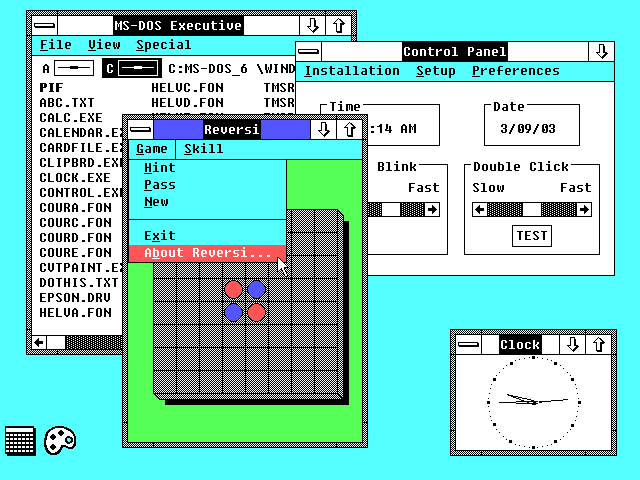Windows 2.0 is the second major release of the Microsoft Windows series of Operating Systems. It was released to manufaturing on December 9, 1987. It refined the User Interface of Windows 1.0 and introduced multiple improvments.
Date released: December 9, 1987
End of Support: December 31, 2001
Last release: Windows 2.03 in December 9, 1987
Succeeded by: Windows 3.0 (released 1990)
Codename: None
Developed by: Microsoft Corporation
Windows 2.0 had 2 different variants: a base version for 8086 real mode (renamed to Windows/286 with the release of Windows 2.1) and Windows/386. The Operating System introduced new features such as overlapping windows, desktop icons, keyboard shortcuts, support for 16-color VGA graphics, and Microsoft Word and Excel. The OS was noted as an improvement over its predecessor.
Release Versions / Editions
The operating environment came in two different variants with different names and CPU support. The basic edition supported the virtual 8086 mode of the 80386 microprocessor. Despite its configuration, the variant was fully operational on an 8088 or 8086 processor, although the high memory area would not be available on an 8086-class processor, however, expanded memory could still be used. IBM's PS/2 Model 25 had an option to ship with a "DOS 4.00 and Windows kit" for educational markets, which shipped Windows with 8086 hardware.
The other variant, named Windows/386, was available as early as September 1987, pre-dating the release of Windows 2.0 in December 1987. It was much more advanced than the other variant. It introduced a protected mode kernel, above which the GUI and applications run as a virtual 8086 mode task. The variant had fully preemptive multitasking, and allowed several MS-DOS programs to run in parallel in "virtual 8086" CPU mode, rather than always suspending background applications. With the exception of a few kilobytes of overhead, each DOS application could use any available low memory before Windows was started and users could run more applications.
Neither version worked with DOS memory managers like CEMM or QEMM or with DOS extenders, which have their own extended memory management and run in protected mode as well. This was remedied in version 3.0, which is compatible with Virtual Control Program Interface (VCPI) in "standard mode" and with DOS Protected Mode Interface (DPMI) in "386 enhanced" mode. Microsoft ended its support for Windows 2.0 on December 31, 2001.
Features
Unlike its predecessor, Windows 2.0 allows the user to overlap and resize application windows. It has also introduced desktop icons, keyboard shortcuts, and the terminology "minimize" and "maximize", as opposed to "iconize" and "zoom" which was used in Windows 1.0. Support for 16-color VGA graphics, EMS memory, and new capabilities of the i386 CPU in some versions were also added. Windows 2.0 is the last version of Windows that ran solely on floppy disks.
The operating environment is shipped with fifteen programs, and it also introduced the GUI based programs Microsoft Word and Excel, to compete against the then-reigning competitors WordPerfect and Lotus 1-2-3. Software such as the Aldus Pagemaker and CorelDRAW were also developed for Windows 2.0.
The Windows API functions are largely handled by KERNEL.EXE, USER.EXE, and GDI.EXE. These files along with device drivers, printer drivers being the exception, are combined by the Windows setup program into WIN200.BIN and WIN200.OVL. The system files WINOLDAP.MOD and WINOLDAP.GRB are used to run MS-DOS programs.
IBM licensed Windows's GUI for OS/2 as Presentation Manager, and the two companies stated that it and Windows 2.0 would be almost identical.
User Interface
Windows 2.0 introduced dialogue boxes which provided a standard way for users to interact with applications. Drop-down menus were introduced in Windows 2.0 which made it easier to access commands from within programs. The standard Window Controls now used the terms "minimize" and "maximize", instead of "iconize" and "zoom". There was little change to MS-DOS Executive, if any. The icons in the Program Manager (seperate from MS-DOS Executive) were further refined and were now more graphical and easier to recognize.
